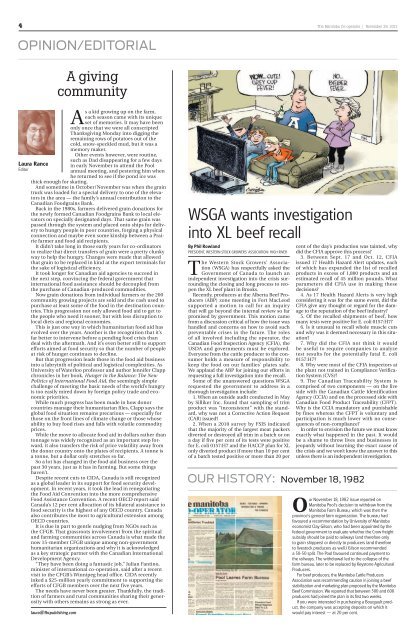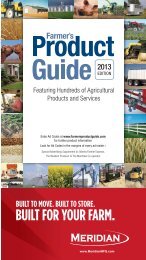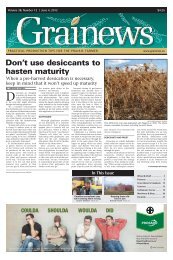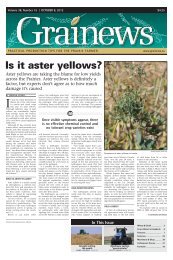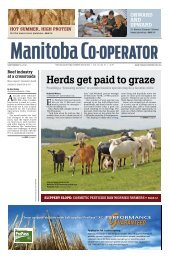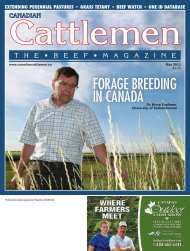farmers decry plan to put transmission towers in fields
farmers decry plan to put transmission towers in fields
farmers decry plan to put transmission towers in fields
You also want an ePaper? Increase the reach of your titles
YUMPU automatically turns print PDFs into web optimized ePapers that Google loves.
4 The Mani<strong>to</strong>ba Co-opera<strong>to</strong>r | November 29, 2012<br />
OPINION/EDITORIAL<br />
A giv<strong>in</strong>g<br />
community<br />
As a kid grow<strong>in</strong>g up on the farm,<br />
each season came with its unique<br />
set of memories. It may have been<br />
only once that we were all conscripted<br />
Thanksgiv<strong>in</strong>g Monday <strong>in</strong><strong>to</strong> digg<strong>in</strong>g the<br />
rema<strong>in</strong><strong>in</strong>g rows of pota<strong>to</strong>es out of the<br />
cold, snow-speckled mud, but it was a<br />
memory maker.<br />
Other events however, were rout<strong>in</strong>e,<br />
such as Dad disappear<strong>in</strong>g for a few days<br />
Laura Rance <strong>in</strong> early November <strong>to</strong> attend the Pool<br />
Edi<strong>to</strong>r<br />
annual meet<strong>in</strong>g, and pester<strong>in</strong>g him when<br />
he returned <strong>to</strong> see if the pond ice was<br />
thick enough for skat<strong>in</strong>g.<br />
And sometime <strong>in</strong> Oc<strong>to</strong>ber/November was when the gra<strong>in</strong><br />
truck was loaded for a special delivery <strong>to</strong> one of the eleva<strong>to</strong>rs<br />
<strong>in</strong> the area — the family’s annual contribution <strong>to</strong> the<br />
Canadian Foodgra<strong>in</strong>s Bank.<br />
Back <strong>in</strong> the 1980s, <strong>farmers</strong> delivered gra<strong>in</strong> donations for<br />
the newly formed Canadian Foodgra<strong>in</strong>s Bank <strong>to</strong> local eleva<strong>to</strong>rs<br />
on specially designated days. That same gra<strong>in</strong> was<br />
passed through the system and placed on<strong>to</strong> ships for delivery<br />
<strong>to</strong> hungry people <strong>in</strong> poor countries, forg<strong>in</strong>g a physical<br />
connection and maybe even some k<strong>in</strong>ship between a Prairie<br />
farmer and food aid recipients.<br />
It didn’t take long <strong>in</strong> those early years for co-ord<strong>in</strong>a<strong>to</strong>rs<br />
<strong>to</strong> realize that direct transfers of gra<strong>in</strong> were a pretty clunky<br />
way <strong>to</strong> help the hungry. Changes were made that allowed<br />
that gra<strong>in</strong> <strong>to</strong> be replaced <strong>in</strong> k<strong>in</strong>d at the export term<strong>in</strong>als for<br />
the sake of logistical efficiency.<br />
It <strong>to</strong>ok longer for Canadian aid agencies <strong>to</strong> succeed <strong>in</strong><br />
the next step, conv<strong>in</strong>c<strong>in</strong>g the federal government that<br />
<strong>in</strong>ternational food assistance should be decoupled from<br />
the purchase of Canadian-produced commodities.<br />
Now gra<strong>in</strong> donations from <strong>in</strong>dividual <strong>farmers</strong> or the 200<br />
community grow<strong>in</strong>g projects are sold and the cash used <strong>to</strong><br />
purchase at least some of the food <strong>in</strong> the dest<strong>in</strong>ation countries.<br />
This progression not only allowed food aid <strong>to</strong> get <strong>to</strong><br />
the people who need it sooner, but with less disruption <strong>to</strong><br />
local diets and regional economies.<br />
This is just one way <strong>in</strong> which humanitarian food aid has<br />
evolved over the years. Another is the recognition that it’s<br />
far better <strong>to</strong> <strong>in</strong>tervene before a pend<strong>in</strong>g food crisis than<br />
deal with the aftermath. And it’s even better still <strong>to</strong> support<br />
efforts aimed at food security so that the number of people<br />
at risk of hunger cont<strong>in</strong>ues <strong>to</strong> decl<strong>in</strong>e.<br />
But that progression leads those <strong>in</strong> the food aid bus<strong>in</strong>ess<br />
<strong>in</strong><strong>to</strong> a labry<strong>in</strong>th of political and logistical complexities. As<br />
University of Waterloo professor and author Jennifer Clapp<br />
chronicles <strong>in</strong> her book, Hunger <strong>in</strong> the Balance: The New<br />
Politics of International Food Aid, the seem<strong>in</strong>gly simple<br />
challenge of meet<strong>in</strong>g the basic needs of the world’s hungry<br />
is <strong>to</strong>o easily mired down by foreign policy trade and economic<br />
priorities.<br />
While much progress has been made <strong>in</strong> how donor<br />
countries manage their humanitarian files, Clapp says the<br />
global food situation rema<strong>in</strong>s precarious — especially for<br />
those on the front l<strong>in</strong>es of climate change or those whose<br />
ability <strong>to</strong> buy food rises and falls with volatile commodity<br />
prices.<br />
While the move <strong>to</strong> allocate food aid <strong>in</strong> dollars rather than<br />
<strong>to</strong>nnage was widely recognized as an important step forward,<br />
it also transfers the risk of price volatility away from<br />
the donor country on<strong>to</strong> the plates of recipients. A <strong>to</strong>nne is<br />
a <strong>to</strong>nne, but a dollar only stretches so far.<br />
So a lot has changed <strong>in</strong> the food aid bus<strong>in</strong>ess over the<br />
past 30 years, just as it has <strong>in</strong> farm<strong>in</strong>g. But some th<strong>in</strong>gs<br />
haven’t.<br />
Despite recent cuts <strong>to</strong> CIDA, Canada is still recognized<br />
as a global leader <strong>in</strong> its support for food security development.<br />
In recent years, it <strong>to</strong>ok the lead <strong>in</strong> renegotiat<strong>in</strong>g<br />
the Food Aid Convention <strong>in</strong><strong>to</strong> the more comprehensive<br />
Food Assistance Convention. A recent OECD report said<br />
Canada’s 12 per cent allocation of its bilateral assistance <strong>to</strong><br />
food security is the highest of any OECD country. Canada<br />
also contributes the most <strong>to</strong> agricultural extension among<br />
OECD countries.<br />
It is due <strong>in</strong> part <strong>to</strong> gentle nudg<strong>in</strong>g from NGOs such as<br />
the CFGB. That grassroots <strong>in</strong>volvement from the spiritual<br />
and farm<strong>in</strong>g communities across Canada is what made the<br />
now 15-member CFGB unique among non-government<br />
humanitarian organizations and why it is acknowledged<br />
as a key strategic partner with the Canadian International<br />
Development Agency.<br />
“They have been do<strong>in</strong>g a fantastic job,” Julian Fant<strong>in</strong>o,<br />
m<strong>in</strong>ister of <strong>in</strong>ternational co-operation, said after a recent<br />
visit <strong>to</strong> the CFGB’s W<strong>in</strong>nipeg head office. CIDA recently<br />
<strong>in</strong>ked a $25-million yearly commitment <strong>to</strong> support<strong>in</strong>g the<br />
efforts of CFGB members over the next five years.<br />
The needs have never been greater. Thankfully, the tradition<br />
of <strong>farmers</strong> and rural communities shar<strong>in</strong>g their generosity<br />
with others rema<strong>in</strong>s as strong as ever.<br />
laura@fbcpublish<strong>in</strong>g.com<br />
WSGA wants <strong>in</strong>vestigation<br />
<strong>in</strong><strong>to</strong> XL beef recall<br />
By Phil Rowland<br />
PRESIDENT, WESTERN STOCK GROWERS’ ASSOCIATION/ HIGH RIVER<br />
The Western S<strong>to</strong>ck Growers’ Association<br />
(WSGA) has respectfully asked the<br />
Government of Canada <strong>to</strong> launch an<br />
<strong>in</strong>dependent <strong>in</strong>vestigation <strong>in</strong><strong>to</strong> the crisis surround<strong>in</strong>g<br />
the clos<strong>in</strong>g and long process <strong>to</strong> reopen<br />
the XL beef <strong>plan</strong>t <strong>in</strong> Brooks.<br />
Recently, producers at the Alberta Beef Producers<br />
(ABP) zone meet<strong>in</strong>g <strong>in</strong> Fort MacLeod<br />
supported a motion <strong>to</strong> call for an <strong>in</strong>quiry<br />
that will go beyond the <strong>in</strong>ternal review so far<br />
promised by government. This motion came<br />
from a discussion critical of how the issue was<br />
handled and concerns on how <strong>to</strong> avoid such<br />
preventable crises <strong>in</strong> the future. The roles<br />
of all <strong>in</strong>volved <strong>in</strong>clud<strong>in</strong>g the opera<strong>to</strong>r, the<br />
Canadian Food Inspection Agency (CFIA), the<br />
USDA and governments must be explored.<br />
Everyone from the cattle producer <strong>to</strong> the consumer<br />
holds a measure of responsibility <strong>to</strong><br />
keep the food on our families’ plates safe.<br />
We applaud the ABP for jo<strong>in</strong><strong>in</strong>g our efforts <strong>in</strong><br />
request<strong>in</strong>g a full <strong>in</strong>vestigation <strong>in</strong><strong>to</strong> the recall.<br />
Some of the unanswered questions WSGA<br />
requested the government <strong>to</strong> address <strong>in</strong> a<br />
thorough <strong>in</strong>vestigation <strong>in</strong>clude:<br />
1. When an outside audit conducted <strong>in</strong> May<br />
by Silliker Inc. found that sampl<strong>in</strong>g of trim<br />
product was “<strong>in</strong>consistent” with the standard,<br />
why was not a Corrective Action Request<br />
(CAR) issued?<br />
2. When a 2010 survey by FSIS <strong>in</strong>dicated<br />
that the majority of the largest meat packers<br />
diverted or destroyed all trim <strong>in</strong> a batch or on<br />
a day if five per cent of its tests were positive<br />
for E. coli 0157:H7 and the HACCP <strong>plan</strong> for XL<br />
only diverted product if more than 10 per cent<br />
of a batch tested positive or more than 20 per<br />
cent of the day’s production was ta<strong>in</strong>ted, why<br />
did the CFIA approve this process?<br />
3. Between Sept. 17 and Oct. 12, CFIA<br />
issued 17 Health Hazard Alert updates, each<br />
of which has expanded the list of recalled<br />
products <strong>in</strong> excess of 1,800 products and an<br />
estimated recall of 45 million pounds. What<br />
parameters did CFIA use <strong>in</strong> mak<strong>in</strong>g these<br />
decisions?<br />
4. As 17 Health Hazard Alerts is very high<br />
consider<strong>in</strong>g it was for the same event, did the<br />
CFIA give any thought or regard for the damage<br />
<strong>to</strong> the re<strong>put</strong>ation of the beef <strong>in</strong>dustry?<br />
5. Of the recalled shipments of beef, how<br />
many tests were positive for E. coli 0157:H7?<br />
6. Is it unusual <strong>to</strong> recall whole muscle cuts<br />
and why was it deemed necessary <strong>in</strong> this situation?<br />
7. Why did the CFIA not th<strong>in</strong>k it would<br />
be useful <strong>to</strong> require companies <strong>to</strong> analyze<br />
test results for the potentially fatal E. coli<br />
0157:H7?<br />
8. Why were most of the CFIA <strong>in</strong>spec<strong>to</strong>rs at<br />
the <strong>plan</strong>t not tra<strong>in</strong>ed <strong>in</strong> Compliance Verification<br />
System (CVS)?<br />
9. The Canadian Traceability System is<br />
comprised of two components — on the live<br />
side with the Canadian Cattle Identification<br />
Agency (CCIA) and on the processed side with<br />
Canadian Food Product Traceability (CFPT).<br />
Why is the CCIA manda<strong>to</strong>ry and punishable<br />
by f<strong>in</strong>es whereas the CFPT is voluntary and<br />
participation is much lower with no consequences<br />
of non-compliance?<br />
In order <strong>to</strong> envision the future we must know<br />
exactly what happened <strong>in</strong> the past. It would<br />
be a shame <strong>to</strong> throw lives and bus<strong>in</strong>esses <strong>in</strong><br />
jeopardy without learn<strong>in</strong>g the exact cause of<br />
the crisis and we won’t know the answer <strong>to</strong> this<br />
unless there is an <strong>in</strong>dependent <strong>in</strong>vestigation.<br />
OUR HISTORY: November 18, 1982<br />
Our November 18, 1982 issue reported on<br />
Mani<strong>to</strong>ba Pool’s decision <strong>to</strong> withdraw from the<br />
Mani<strong>to</strong>ba Farm Bureau, which was then the<br />
prov<strong>in</strong>ce’s general farm organization. The bureau had<br />
favoured a recommendation by University of Mani<strong>to</strong>ba<br />
economist Clay Gilson, who had been appo<strong>in</strong>ted by the<br />
federal government <strong>to</strong> evaluate whether the Crow freight<br />
subsidy should be paid <strong>to</strong> railways (and therefore only<br />
<strong>to</strong> gra<strong>in</strong> shippers) or directly <strong>to</strong> producers (and therefore<br />
<strong>to</strong> lives<strong>to</strong>ck producers as well.) Gilson recommended<br />
a 50-50 split. The Pool favoured cont<strong>in</strong>ued payment <strong>to</strong><br />
the railways. The withdrawal led <strong>to</strong> the collapse of the<br />
farm bureau, later <strong>to</strong> be replaced by Keys<strong>to</strong>ne Agricultural<br />
Producers.<br />
For beef producers, the Mani<strong>to</strong>ba Cattle Producers<br />
Association was recommend<strong>in</strong>g caution <strong>in</strong> jo<strong>in</strong><strong>in</strong>g a beef<br />
stabilization and market<strong>in</strong>g <strong>plan</strong> proposed by the Mani<strong>to</strong>ba<br />
Beef Commission. We reported that between 500 and 600<br />
producers had jo<strong>in</strong>ed the <strong>plan</strong> <strong>in</strong> its first two weeks.<br />
If you were <strong>in</strong>terested <strong>in</strong> purchas<strong>in</strong>g a Bourgault product,<br />
the company was accept<strong>in</strong>g deposits on which it<br />
would pay <strong>in</strong>terest — at 20 per cent.


